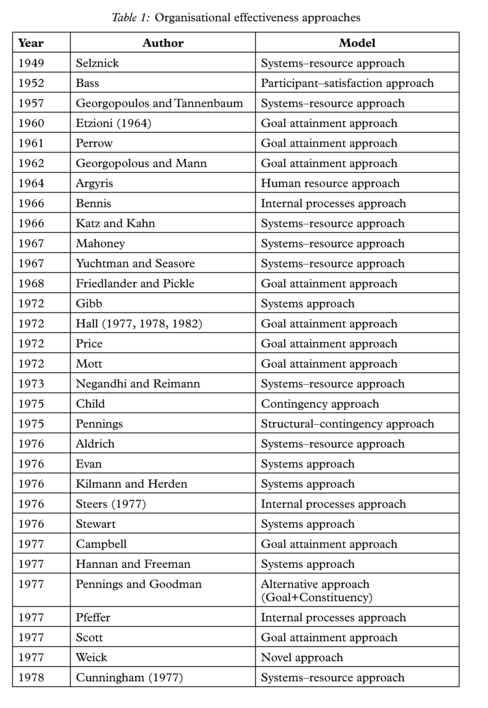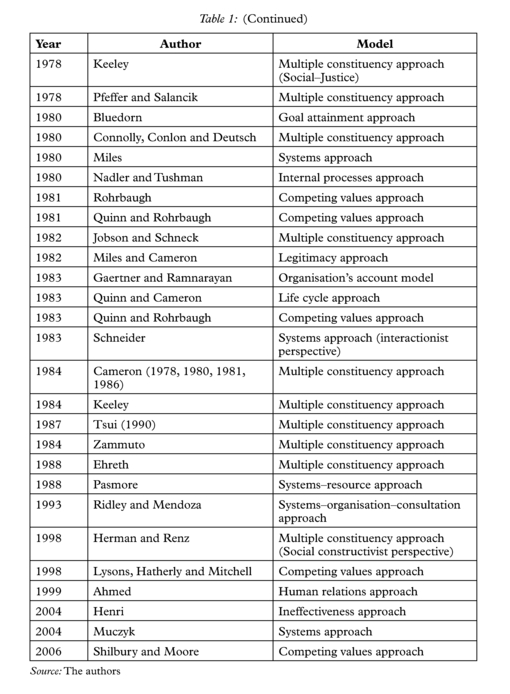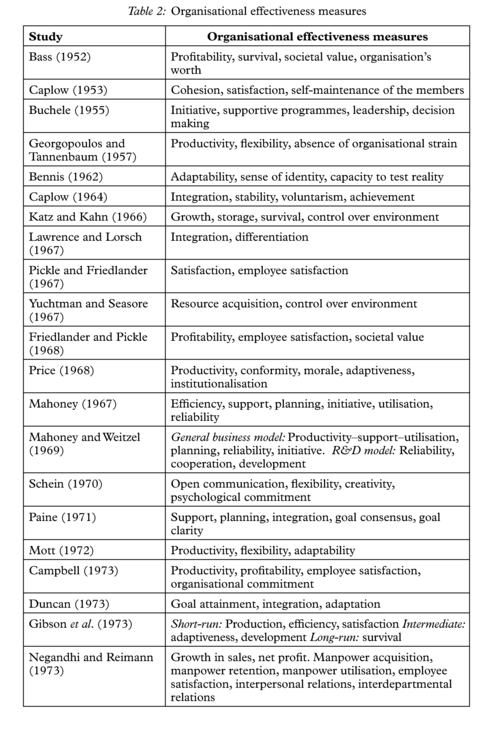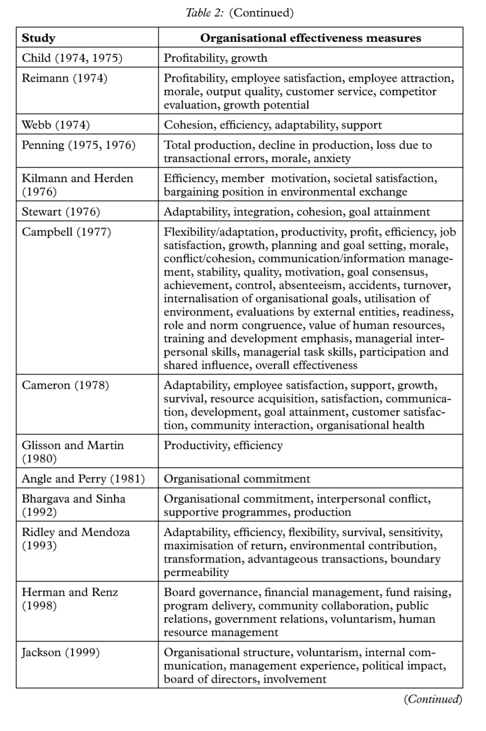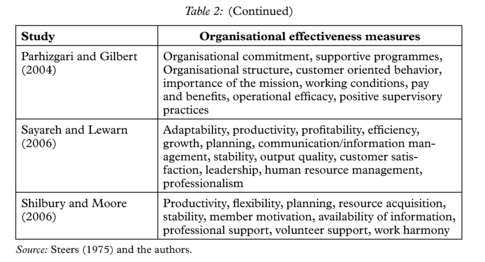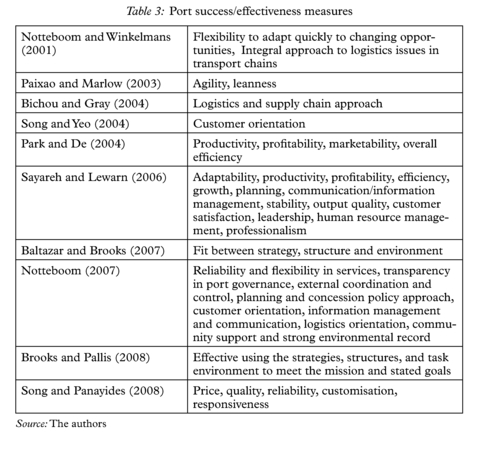Organisational Change and Effectiveness in Seaports from a Systems Viewpoint

Chapter 32
Organisational Change and Effectiveness in Seaports from a Systems Viewpoint
Cimen Karatas Cetin* and A. Güldem Cerit†
1. Introduction
Ports are not only the intersection points between land and sea transport systems, but they are regarded as more complex, logistics and multimodal transport centres and value added organisations. Seaports are the main links in the supply chain systems that add value to the port users and final customers. Ports play an important role in the management and co-ordination of materials and information flows, as the transport is an integral part of the entire supply chain (Carbone and Martino, 2003).
Ports play the significant role in this system by providing effective functioning of the whole system and creating value to the players of the supply chain. The instigation of new logistics patterns of maritime and intermodal transportation means that modern ports can now compete for far-reaching cargoes with far-distant counterparts (Bichou and Gray, 2005). Therefore, overall organisational effectiveness should be achieved in seaports for maintaining the competitive positions in the port industry.
While the seaports have uncertainty and complexity in their environments their effectiveness can be achieved by the flexibility of the ports against the changing conditions, intensive communication between the parties in the supply chain, quality and efficiency of the operations and in brief the integrity of the whole system. However, these measures of effectiveness are not the only ones. From the earlier stages of organisational theory on effectiveness to present, there is still an ambiguity about the definition and measurement criteria of effectiveness.
In the port system, there is a direct link between the change and effectiveness concepts. A port cannot be effective without adapting to the changes in its environment. As a sub-system of the supply chain, the seaports are affected from the changes in the logistics and supply chain, transport industry and in a broader concept the trade and manufacturing industry. The fluctuations in these markets have direct and indirect effects on port organisation and managements.
Seaports are open systems interacting with their turbulent environments and affecting world trade with their maritime transport and technological developments. They are like living organisms being exposed to change every day. As Darwin claimed in “Origin of the Species”; “it is not the strongest species that will survive, nor the most intelligent, but the one most responsive to change”, the ability of responsiveness and flexibility to the changing market and environmental conditions is a must for the survival of seaport organisations. However, survival is not enough in today’s competitive transport market. The important point here is how to manage change to achieve organisational effectiveness and sustain competitive advantage.
When we look at the organisation theories of change and effectiveness, the direct link can easily be seen. Main objective of organisations conducting change is to achieve effectiveness. These two terms can be analysed from the systems viewpoint which perfectly fits with the nature of the seaport systems.
In this study first of all, the systems approach to management is widely explained containing the theories developed and methods conducted. The meaning of effectiveness and its differences between the terms efficiency and performance are stated. Then the meaning of and approaches to organisational effectiveness are explained. The main approaches to and measures of organisational effectiveness are stated by a broad review of the management studies in this field. The systems approach, which emphasises both the subsystems (internal) in the organisation and the interaction of the organisation with its environment (external) is clarified and found applicable to determine the main measures of effectiveness in seaports.
Then, the organisational change concept; the types, theories about change, and the methods of change are defined. The relationship between the organisational change and effectiveness concepts are stated. The port organisations as value-added systems, their relations and integrations with the supply chain and the turbulence in their environments are explained. The importance of adaptability to the changing conditions is clarified.
As effectiveness cannot be achieved without adapting to the changes in the environment, a model concerning ports “as complex adaptive systems” has been developed including the effects of changes in logistics and transport systems, supply chain system and global production and trade system to the port system.
Finally, with combining the change and effectiveness concepts in port management “an organisational change and effectiveness model for ports” is developed. The four basic steps in the model are respectively: external drivers for change as determinants; port system model as the organisation system; methods of change as the intervention strategy used in the change process; and finally, the major port effectiveness measures.
2. Systems Theory in Management
All organisations function:
- within the value patterns of cultural environment in which they are embedded;
- within the political structure or pattern of legal norms and statues that define their formal legitimacy and limit their activities;
- within the economic environment of competitive markets and competitive sources of input such as labor force and materials;
- within the informational and technological environment;
- within the natural and physical environment of geography, natural resources and climate.
In other words, organisations exist and adapt to five environments – the cultural, the political, the economic, the technological and the ecological (Katz and Kahn, 1978). Emery and Trist (1965) described the four general dimensions of environment as stability/turbulence, uniformity/diversity, clustered/random, scarcity/munificence. Systems Theory paradigm is being used extensively in the investigation of relationships between subsystems within organisations and in studying the environmental interfaces (Kast and Rosenzweig, 1972).
From a systems theory perspective, an organisation is a social system which, in its interaction with its environment, activates at least four systemic processes:
- inputs of various types of resources;
- transformations of resources with the aid of social and/or technical mechanism;
- outputs which are transmitted to other systems; and
- feedback effects whether negative or positive (Evan, 1976).
The term “systems approach” is applied to
- the formulation of systems and subsystems;
- the relating of changes in any part of the system to total performance; and
- the use of a developing body of knowledge related to the functioning and measurement of various types of systems (Fox, 1974).
According to Optner (1968) a “system” is defined as some ongoing process of a set of elements, each of which are functionally and operationally united in the achievement of an objective. Cleland and King (1975) defines a “system” as an organised or complex whole, an assemblage or combination of things and parts forming a complex and a unitary whole. According to the systems theory, a “system” is an organised, unitary whole composed of two or more independent parts, components or subsystems and delineated by identifiable boundaries from its environmental supra-system. According to Kast and Rosenzweig (1979) an organisation’s subsystem – an interdependent component with some relationship in an organisation – is composed of goals and values, technical, psychosocial, structural and managerial subsystems. The social structure of the organisation is previously defined by Etzioni (1960) as: “the organisations are the systems of coordinated activities of more than one actor.”
The five basic considerations about the definition of the systems are (Churchman, 1979):
- the total system objectives and the performance measures of the whole system;
- the system’s environment;
- the resources of the system;
- the components of the system, their activities, goals and measures of performance; and
- the management of the system.
The system concept includes two different definitions according to their interactions with the environment: the closed and open systems. The closed system has rigid, impenetrable boundaries, whereas the open system has permeable boundaries between itself and a broader supra-system. The boundaries set the domain of the organisation’s activities (Berrien, 1976).
The derivation of the general systems theory relevant to formal human work organisations has the name open systems theory. The central propositions of this theory are concerned with system boundaries, differentiation and integration of the subsystems that are parts of the focal system, input–transformation–output processes, boundary transactions and system maintenance processes (Seashore, 1983).
Open systems theory emphasises the close relationship between a structure and its supporting environment. The other major emphasis is on throughput: the processing of production inputs to yield some outcome that is then used by an outside group or system. According to Katz and Kahn (1978) open systems have 10 main characteristics including importation of energy, the throughput, the output, systems as cycles of events, negative entropy, information input, negative feedback and the coding process, the steady state and dynamic homeostasis, differentiation, integration and coordination and equifinality. As organisations are open systems, Jackson (2000) proposes that the primary subsystems of an organisation are mainly: the goal, technical, human and managerial subsystems.
The interaction of the organisation with its internal resources to the changing environment refers that they are open systems which places a great deal of emphasis on flexibility and external focus, and would stress flexibility and readiness (as means) and growth, resource acquisition, and external support (as ends) (Quinn and Rohrbaugh, 1983). Open systems emphasises the distinctiveness of the organisation as an identifiable social structure or entity, and it emphasises the interdependency processes that relate the organisation to its environment (Yuchtman and Seashore, 1967). The “organisations-as-open systems” approach looks at all the subsystems, their interrelationships, and the interactions between the subsystems (and the organisation as a whole) and the environment (Jackson, 2000).
In the socio-technical systems approach, the goals and values, as well as the technical, structural, psycho-social and managerial subsystems are shown as the integral parts of the overall organisation (Kast and Rosenzweig, 1972). Social organisations are flagrantly open systems in that the input of energies and the conversion of output into further energetic input consist of transactions between the organisation and its environment. Every surviving system must provide some output acceptable usually to a collateral or supra-system (Berrien, 1976). Two basic criteria for identifying social systems and determining their functions are (1) tracing the pattern of energy exchange or activity of people as it results in some output, and (2) ascertaining how the output is translated into energy that reactivates the pattern (Katz and Kahn, 1978).
In a social system, the organisational boundaries are not easily definable and are determined primarily by the function and activities of the organisation (Berrien, 1976). A reason for the indefiniteness of the boundaries in a social organisation is the rapidly changing conditions in its environment and the continuous interaction between the environment and organisation. Organisations do not exist in a static world. The surrounding environment is in a constant state of flux, and a rigid technical system, even if protected by excellent support structures. Organisations develop adaptive structures whose function is to gather advance information about trends in the environment, carry out research on internal productive processes, and plan for future developments (Katz and Kahn, 1978). These complex adaptive systems are open systems in intimate interchange with an environment characterised by a great deal of shifting variety and its constraints (Buckley, 1968). Morel and Ramanujam (1999) state that organisations are routinely viewed as dynamic systems of adaptation and evolution, which contain multiple parts that interact with one another and the environment.
Another approach to measure the complex dynamics systems has been conceived and developed in the late 1950s in Massachusetts Institute of Technology by Jay Forrester and his team. The advent of System Dynamics (SD) is generally considered to be the publication of Forrester’s pioneering book, “Industrial Dynamics” in 1961 (Santos et al., 2002). Sterman (2000) used system dynamics modelling for the analysis of policy and strategy, with a focus on business and public policy applications. System Dynamics has its origins in control engineering and management; the approach uses a perspective based on information feedback and delays to understand the dynamic behaviour of complex physical, biological, and social systems (Angerhofer and Angelides, 2000). It focuses on the structure and behavior of systems composed of interacting feedback loops. The objective of this approach is to capture the dynamic interaction of different system variables and to analyse their impact on policy decisions over a long-term horizon (Sachan et al., 2005).
System Dynamics is widely used in business and management fields and related to our study is a method that portrays the process of organisational change. Many studies have been published about the application of system dynamics methodology to the process of change in organisations (Frechette and Spital, 1991; Samuel and Jacobsen, 1997). SD is also used in supply chain management (Angerhofer and Angelides, 2000; Kumar and Yamaoka, 2007) and in maritime transport concepts (Engelen et al., 2006).
3. Organisational Effectiveness and Systems Approach
Organisations are constructed to be the most effective and efficient social units. The actual effectiveness of a specific organisation is determined by the degree to which it realises its goals. There is some further ambiguity between the terms efficiency and effectiveness. Efficiency defines how well the processes of the organisation perform (Jumara, 2005) and the efficiency of an organisation is measured by the amount of resources used to produce a unit of output (Etzioni, 1964). Efficiency is an economic index of the ratio of measured inputs to measured outputs (Cummings, 1983). Effectiveness is a term related with the outputs and goals of an organisation; however efficiency describes the optimal use of current resources (Hirsch, 1975). Katz and Kahn (1966) linked effectiveness explicitly to an external referent, and efficiency to internal activities more easily controlled by the organisation and state that efficiency is a criterion of the internal life of the organisation, especially the economic and technical aspects (Katz and Kahn, 1978). However, the effectiveness is the aggregation of opportunities provided to the members of the unit (in the case of the organisational level, it is the opportunities provided by organisational membership to the individual). For an organisation to be effective, a subsystem must be concerned with showing that performance meets the standards that external and internal constituencies (e.g. resource suppliers and customers) monitor (Cummings, 1983).
In some studies of organisational effectiveness (Gibson et al., 1973; Webb, 1974), efficiency is used as a criterion for the measurement of effectiveness of an organisation. Cunningham (1977) defines efficiency from the organisational and systems perspective and states that efficiency is an indication of the organisation’s ability to use its resources in responding to the most important subsystem needs. However, Sproles (2001) states that effectiveness is the domain of the end user who wishes to know if the system is able to meet a need (Sayareh, 2007).
Barnard (1938) reasoned that organisations are “co-operative systems.” His definition of organisational effectiveness is couched in terms of the process of cooperation. Organisational effectiveness is the accomplishment of the recognised objectives of the cooperative action. However, organisational efficiency is defined as follows: the efficiency of a cooperative system is the resultant of the efficiencies of the individuals furnishing the constituent efforts, that is, as viewed them (Barnard, 1938). Effectiveness and efficiency are achieved through the interactions among people as managed by both the formal (studied by traditional theory) and informal (studied by human relations theory) structures of the enterprise (Jackson, 2000).
In the management discipline many researchers studied the relationship between the organisational effectiveness and the environment of the organisations (Etzioni, 1960; Yuchtman and Seashore, 1967; Osborne and Hunt, 1974; Hirsch, 1975). According to Yuchtman and Seashore (1967) most existing definitions of organisational effectiveness have been formulated, implicitly or explicitly, in terms of a relation between the organisation and its environment. A study of effectiveness has to include an analysis of the environmental conditions and of the organisation’s orientation to them (Etzioni, 1960). Hirsch (1975); Lawrence and Lorsch (1967) and Negandhi and Reimann (1973) are all concerned with the interrelationships between organisational structure and environment, which prompts them to measure organisational effectiveness.
Katz and Kahn (1966) proposed defining organisational effectiveness as “the maximisation of return to the organisation by all means.” Georgopoulos and Tannenbaum (1957) concur with this statement and explicate that the definition of organisational effectiveness must encompass two aspects: the objectives of organisations (the ends); and the means through which they sustain themselves and attain their objectives. Robbins (1990) also states that organisational effectiveness must consider both means (process) and ends (outcomes).
Organisational effectiveness may be typified as being mutable (composed of different criteria at different life stages), comprehensive (including a multiplicity of dimensions), divergent (relating to different constituencies), transpositive (altering relevant criteria when different levels of analysis are used), and complex (having non-parsimonious relationships among dimensions) (Cameron, 1978).
3.1 Approaches to organisational effectiveness
The widely studied and practiced organisational effectiveness models include the goal attainment approach (Etzioni, 1960), the systems resource approach (Yuchtman and Seashore, 1967), the internal process approach (Bennis, 1966; Steers, 1977; Pfeffer, 1977; Nadler and Tushman, 1980), the human relations approach (Argyris, 1964; Ahmed, 1999), the multiple/strategic constituencies approach (Pfeffer and Salancik, 1978; Connolly et al., 1980; Jobson and Schneck, 1982; Keeley, 1984; Tsui, 1987; Zammuto, 1984; Ehreth, 1988), the competing values approach (Quinn and Rohrbaugh, 1983; Shilbury and Moore, 2006) and the ineffectiveness approach (Henri, 2004).
- The goal attainment approach views effectiveness in terms of internal organisational objectives and performance (Molnar and Rogers, 1976) and organisations as purposeful and coordinated agents (Georgopoulos and Tannenbaum, 1971). Keeley (1978) proposes two variants of the goal models: official and operative goal models.
- The internal process approach focuses on the internal functions of the organisation and stability and efficiency remain two of the criteria of such effectiveness (Heffron, 1989).
- The human relations approach focuses on the people and upholds the satisfaction of employees’ needs as the most important end (Argyris, 1964).
- The strategic constituencies approach proposes that an effective organisation is one that satisfies the demands of those constituencies in its environment from whom it requires support for its continued existence (Robbins, 1990).
- The competing values approach constitutes a synthesis and an extension of the other organisational effectiveness models (Pfeffer and Salancik, 1978; Quinn and Rohrbaugh, 1983).
- The ineffectiveness approach’s basic assumption is that it is easier, more accurate, more consensual and more beneficial to identify problems and faults (ineffectiveness) than criteria of competencies (effectiveness) (Henri, 2004).
- The system approach views organisations as open systems, which work in close relationship with the environment (Yuchtman and Seashore, 1967; Molnar and Rogers, 1976; Ahmed, 1999).
A review of organisational effectiveness literature between the years 1949–2009 shows that there are many different approaches to the effectiveness concept in organisations. Table 1 encompasses 58 publications, composed of books, book chapters and important articles in leading academic journals in business and management fields. Many of the authors wrote in the early stages of the organisational effectiveness concept and are the pioneer theorists in this field (Etzioni, 1960; Yuchtman and Seashore, 1967; Pfeffer and Salancik, 1978). The approaches to the concept changed and developed through the years. Some alternative models which were generally the enhanced versions of the main approaches mentioned above were developed and applied to different types of organisations in recent years (Ridley and Mendoza, 1993; Herman and Renz, 1998; Ahmed, 1999; Henri, 2004).
The systems approach to organisational effectiveness is a widely studied model as can be seen from Table 1. Seventeen (29%) of the authors used the principles of this approach in explaining and measuring effectiveness. The goal-attainment and multiple constituency approaches are both discussed in 10 publications, where competing values approach is embraced by five authors and internal process approach just by four.
3.2 Systems approach to organisational effectiveness
The concept of organisational effectiveness is ordinarily used to refer to goal attainment (Georgopoulos and Tannenbaum, 1957). But, according to Etzioni (1960) the system model is theoretically more powerful and avoids certain value judgments than the goal model of organisational effectiveness.
According to Yuchtman and Seashore (1967) an adequate conceptualisation of organisational effectiveness cannot be formulated unless factors of organisation–environment
relationships are incorporated into its framework. However, both the goal and functional approaches cannot give an adequate consideration to the conceptual problem of the relations between the organisation and its environment.
Gaertner and Ramnarayan (1983) categorise organisational effectiveness approaches according to two dimensions: focus of definition (process/structure or outcome) and intended use concepts (general or organisation-specific). The systems approach is located in the intersection of process/structure and general concept. This refers that systems approach is not only related with the outputs and goals of the organisation, but also the process/structure and means (resources) used in this process are the main concerns in this approach. This approach takes the environment and the whole system into consideration, not just the organisation itself.
In the systems approach of the organisational effectiveness the starting point is not the goal itself, but a working model of a social unit which is capable of achieving a goal (Etzioni, 1960) which focuses on behavior conceived as continuous processes of exchange and competition over scarce and valued resources rather than focusing on goals only (Yuchtman and Seashore, 1967). Unlike a goal, it is a model of a multi-functional unit.
Georgopoulos and Tannenbaum (1957) define organisational effectiveness from the systems perspective as: “Organisational effectiveness is the extent to which an organisation as a social system, given certain resources and means, fulfills its objectives without incapacitating its means and resources and without placing undue strain upon its members.”
The systems resource model defines the organisation as a network of interrelated subsystems. The outputs of one subsystem may become the inputs of another subsystem; the organisational system functions effectively to the degree that its subsystems are in harmony and are coordinated to work together (Cunningham, 1977). Universally required resources are mainly, personnel, physical facility, technology and money as a liquid resource (Yuchtman and Seashore, 1967).
In the systems resource model, the interdependence between the organisation and its environment takes the form of input–output transactions. Three phases of the systems model are: the importation of resources, their use (including allocation and processing) and their exportation in some output form that aids further input (Yuchtman and Seashore, 1967).
According to Cunningham (1977) an organisation, in order to survive, must satisfy some basic needs: (1) acquiring resources; (2) interpreting the real properties of the external environment; (3) production of outputs; (4) maintenance of internal activities; (5) coordination of relationships between subsystems; (6) responding to feedback; (7) evaluating the effect of its decision; and (8) accomplishing goals.
However there are some limitations of the systems approach to organisational effectiveness. The three most important shortcomings of this approach relate to the fact that measurements for all of a systems needs are difficult to develop (Cunningham, 1977), the debate that whether means really matter (Robbins, 1990) and are more expensive for the researcher (Etzioni, 1960).
The systems approach looks at factors such as relations with the environment to assure continued receipt of inputs and favourable acceptance of outputs, flexibility of response to environmental changes, the efficiency with which the organisation transforms inputs to outputs, the clarity of internal communications, the level of conflict among groups and the degree of employee job satisfaction (Robbins, 1990).
General systems theory with its biological orientation would appear to have an evolutionary view of system effectiveness. The living system which best adapts to its environment prospers and survives. But, this is not the case in social organisations. According to Kast and Rosenzweig (1972) the questions of organisational effectiveness must be concerned with at least three levels of analysis: the level of the environment, the level of the social organisation as a system, and the level of the subsystems (human participants) within the organisation Emery and Trist (1959) stress that the primary task of managing an enterprise as a whole is to relate the total organisational system to its environment, and not just internal regulation. The basic organisations-as-systems prescription remains: if an organisation is not functioning effectively, examine its subsystems to see that they are meeting its needs to ensure it is well adjusted to its environment (Jackson, 2000).
3.3 Measures of organisational effectiveness
Evaluating the overall effectiveness of an organisation is one of the most difficult problems in organisation theory. There is still a lack of consensus as to measure what constitutes a useful and valid set of effectiveness. According to Steers (1975) this is because effectiveness is an abstract idea rather than a concrete phenomenon. Quinn and Rohrbaugh (1983) concur with this idea and state that effectiveness is not a concept but a construct. Henri (2004) agrees and states that there is a serious ambiguity and confusion surrounding the construct of effectiveness.
Steers (1975) states that researchers face many problems in the measurement of organisational effectiveness. The ambiguity of the construct “effectiveness”, the transitory nature of the many effectiveness criteria, the conflicts that can emerge between these criteria, the difficulty to measure them and the inapplicability of the same criteria to different situations and organisations are the main problems in the measurement of organisational effectiveness.
The criteria of an effective organisation can be classified into two categories: (a) tangible or inorganic criteria; and (b) intangible or organic criteria. The tangible or inorganic criteria refer to the quantitative measures of an organisation (Sahni, 2000) such as performances in finance, sales, manufacturing, purchasing, and profits.
It is possible to identify two general types of models: (1) normative, or prescriptive, models, which attempt to specify those things an organisation must do to become effective; and (2) descriptive models, which attempt to summarise the characteristics found in successful organisations (Steers, 1975).
A useful framework for assessing organisational effectiveness suggests four main categories: (1) achieving goals; (2) increasing resourcefulness; (3) satisfying clients; and (4) improving internal processes (Cameron, 1980; Bramley, 1986; Redshaw, 2000).
Yuchtman and Seashore (1967) specify the steps needed for the comparative assessment of organisational effectiveness: (1) to provide a taxonomy of resources; (2) to identify the different types of resources that are mutually relevant for the organisations under study; and (3) to determine the relative positions of the compared organisations on the basis of information concerning the amount and kinds of resources that are available for the organisation and its efficiency in using these resources to get further resources.
Georgopoulos and Tannenbaum (1957) observed that the common practice of measuring effectiveness by univariate measures, such as productivity or profit, was inconsistent with the broad meaning attached to effectiveness in the organisational literature (Keeley, 1978). Many researchers have studied several possible criteria available in the measurement of organisational effectiveness. A major advantage of the multivariate
models is their comprehensive nature, subsuming several variables under one unifying framework. Unfortunately, this advantage can simultaneously represent a major weakness where such criteria are in conflict with one another (Steers, 1975).
As an extension of Table 1, Table 2 lists the studies and the major organisational effectiveness criteria used in these studies. The studies cover the articles, book chapters and books in this field. By the review of many theoretical and empirical publications on organisational effectiveness concept, just 38 of them prominently state the effectiveness measures that should be used or are used in their studies. A total of 107 effectiveness measures are derived from these studies. The frequencies of occurrence of these criteria are measured. As a criterion of effectiveness, adaptability has the maximum frequency with 11; however flexibility which has a very close meaning with adaptability has a frequency of 6. Many studies use these measures interchangeably. Therefore, the adaptability and flexibility concepts can be combined and used as a single criterion. According to the results, the other important measures of effectiveness and their frequencies are productivity (10), profitability (8), efficiency (8), employee satisfaction (7), support (6), growth (6), planning (6), survival (5), integration (5), resource acquisition (4), morale (4), organisational commitment (4), cohesion (4), satisfaction (4), communication (4) and stability (4).
The main effectiveness criteria are the tangible measures such as productivity, profitability and efficiency whose measurements are easier than the intangible measures. The intangible measures are related to the human resources of the organisation like satisfaction, morale, commitment and cohesion. These are related to the internal processes of the organisation where the tangible measures have an external focus and are directly related to its goals. When we look at the results, it is obvious that the criteria used in systems approach to measure the organisational effectiveness are adaptability/flexibility, support, growth and resource acquisition (Quinn and Rohrbaugh, 1983) have high frequencies and are widely used in the assessment of organisational effectiveness.
4. A Systems Model of Organisational Effectiveness at Ports
In port business literature, there have been many studies relating to port performance and efficiency (Monie, 1987; Tongzon, 1995; De Langen, 2001; Tongzon, 2001; De and Ghosh, 2003; Paixao and Marlow, 2003b; Bichou and Gray, 2004; Barros and Athanassiou, 2004; Lam 2005; Wang and Cullinane, 2006; Wang et al., 2006; De Langen et al., 2006; Owino et al., 2006; Panayides and Song, 2006; Beresford and Pettit, 2007; Brooks and Pallis, 2007; Wang et al., 2007). De Langen et al. (2006) lists the name and definitions of the major port performance indicators in their study. However there are only a few approaches considering the effectiveness of seaport organisations (Sayareh and Lewarn, 2006; Sayareh, 2007).
The difference between the measures of effectiveness and performance is that a measure of effectiveness is a standard against which we judge how well we achieved what we intended or wanted to achieve; a measure of performance is the measure of what was achieved (Sproles, 2000). It can be referred that measures of effectiveness are representative of certain properties of the solution and they are concerned with the outcomes (external view) of a solution (Sproles, 2002).
As mentioned above there are not many studies about the effectiveness concept in port management, however some studies use port success or port competitiveness terms that can be used in place of the term effectiveness. Table 3 lists some port studies that mention the measures a port should achieve to be successful or, in other words, effective. Within these studies only Sayareh and Lewarn’s, 2006 study uses the term “port effectiveness”.
As discussed earlier, multiple criteria should be used for assessing the organisational effectiveness of seaports. It is because of the complexity and dynamism in the structure (sub-systems) and environment of the port systems. A system model of organisatinoal effectiveness is a model of a multi-functional unit, considering the inputs that are needed for the process/transformation and the outputs that may become the inputs of another following subsystem. Where the seaports are the major parts of the supply chain system and have a complex structure containing many different interdependent units, the systems approach to organisational effectiveness is used as the model (Karatas and Cerit, 2008). This approach has three basic elements which are inputs or resources that are needed for a process/subsystem, the process itself and the outputs or outcomes of these processes.
In the systems approach to organisational effectiveness it is recognised that no organisation can reach overall effectiveness if one or more subsystems are performing inadequately. Therefore the subsystems in a seaport organisation should be identified to reach and assess the whole effectiveness of the system.
Since the seaports are multi-functional and multi-faceted organisations with complex structures, they encompass many functions in their systems. These functions or subsystems can also be regarded as the processes or transformations in the ports. Every function needs certain inputs where some subsystems have common inputs used to form outputs. The outputs of each function and the coherence and harmony between these functions directly affect the effectiveness of the port system.
The systems model of seaport effectiveness covers 11 port sub-systems which are mainly the port engineering facilities (port infrastructure, superstructure, equipment repair and maintenance); port operations (cargo handling, pilotage and towage and
services to ships); logistical and industrial aspects (value-added services, distribution parks, manufacturing facilities); social issues (port labour, interaction with the city and nation); economic and financial issues (economic impact to the region, creation of employment, arrangement of port tariffs, profit, finance of investments, employee expenditures); political and legal issues (customs, immigration); environmental issues (marine pollution); safety and security issues; marketing issues (customer relations); human resources (relations with employees, motivation, training); and finally, organisational and managerial issues (organisation structure, leadership, strategic planning).
The effectiveness measures that are also applicable to port organisations are categorised as outputs under the port sub-systems according to the relevancy with each sub-system. The major effectiveness measures for each port process are listed in Table 4.
All these facets or different interdependent units of the port system intersect at one point, at the port management function which reflects the overall effectiveness of the seaport organisation.
5. Organisational Change Concept
Representative descriptions of change vary with the level of analysis (Ford and Ford, 1994). At the most general level, change is a phenomenon of time. It is the way people talk about the event in which something appears to become, or turn into, something else, where the something else is seen as a result or outcome (Weick and Quinn, 1999).
There is no single accepted definition of organisational change. This is perhaps not surprising given the wide diversity of change experienced by organisations and individuals. Porras and Silvers (1991) define organisational change as the “process by which organisations move their present state to some future state to increase effectiveness” (Jumara, 2005). From the perspective of organisational development, change is a set of behavioural science-based theories, values, strategies, and techniques aimed at the planned change of the organisational work setting for the purpose of enhancing individual development and improving organisational performance, through the alteration of organisational members on-the-job behaviour (Porras and Robertson, 1992). Hitt et al. (1998) state that organisational change is closely connected to the technology explosion phenomenon – particularly with respect to information and telecommunication technologies, also to the resulting globalisation of economic activities through free trade and movement of products and capital and, to a lesser but accelerating extent, of human resources (Prastacos et al., 2002).
5.1 Theories of change
In the 1950s, social psychologist Kurt Lewin developed a theory of social change. According to his theory, successful change requires unfreezing the status quo, moving to a new state and refreezing the change to make it permanent (Robbins, 1990). Some researchers have put together more complete models of understanding change, Hinings and Greenwood’s (1988) model of change dynamics, Pettigrew’s (1985) process/content/context model, and Burnes (2004) change management framework are all in this category (Bamford and Daniel, 2005). Kanter et al. (1992) claimed that change is both “ubiquitous and multidirectional” and thus Lewin’s model does not come close to the level of complexity needed to address the phenomenon of organisational change (Hatch, 1997). Kanter et al. (1992) defined organisations as a “bundle of activities” and claim that change itself occurs at three levels of analysis specified by organisation theory – environment (macroevolutionary forces for change), organisation (microevolutionary forces for change) and individual (political forces for change). In symbolic– interpretive theory, the changes are more normative in nature and the entire system is a political and socially constructed reality rather than the economic and technological reality of the modernist perspective (Hatch, 1997).
Van de Ven and Poole (1995) identify four process theories of organisational change and development according to the unit and mode of change: life-cycle, evolutionary, dialectical and teleological (Gebhart, 2004). According to their meta-theoretical scheme; the life-cycle model depicts a prescribed change within an entity, the teleological model contains a constructive change within an entity. However, in evolutionary model and dialectical models, change takes place in multiple entities, but modes of change differ as being prescribed and constructive respectively. Van de Ven and Poole (2005) developed a typology of four approaches to study organisational change. They looked organisational change according to ontological and epistemological aspects including two approaches: variance and process approaches to organisational change.
5.2 Types of change
From the literature of organisational change and development there would appear to be two main approaches to change: planned and emergent.
